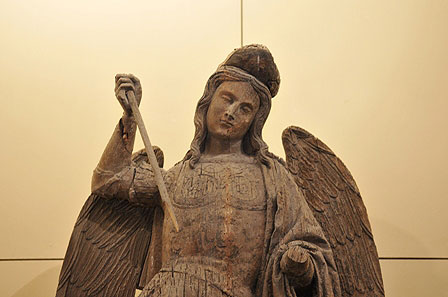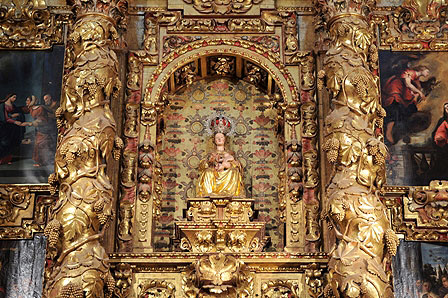BRINGING HERITAGE CLOSER. CORELLA
26 August 2010
The image of the Rosary and Saint Michael in the Arts
Ms Mª Gabriela Torres Olleta. GRISO. University of Navarra
To understand religious works of art, it is essential to ask ourselves what they want to tell us. Religious art was not created to be contemplated in museums by a spectator with an exclusively aesthetic interest: its raison d'être is always spiritual. On this occasion, we will look at the representations of Saint Michael and the Rosary in the titular art of the two large churches of Corella.
Devotion to Saint Michael appeared very early among the first Christians. At the same time as the cult, artistic representation developed. The iconography of this Archangel, one of only three mentioned in the Bible, will emerge from the confluence of oriental, classical and biblical traditions and visual forms to which, over the centuries, those contributed by new texts such as the Apocryphal Gospels, the Golden Legend or the Mystical City of God by Sister María Jesús de Ágreda will be added.
The iconography which we could call the main one is that of the angel as the executor of Divine Justice, Princeps militiae angelorum, the warrior who fights the dragon at the head of the heavenly armies. The fundamental text is found in the book of Revelation 12.
The Romanesque representations on the façade of San Miguel in Estella and the Speciosa door in Leyre are noteworthy. In the Gothic style, the panel by Miguel Jiménez (1475-1485), now in the Prado, stands out. Moving forward in time, we should remember the Saint Michael by the so-called Maestro de Zafra in the Prado Museum, and in Corella itself we find a beautiful wooden carving from an altarpiece from the end of the 15th century. In the Baroque period there are numerous examples of this typology, such as the work of Luisa Roldán del Escorial or the main figure of the parish church of Corella itself, from the 18th century.
The following iconographic subject corresponds to Saint Michael at the moment of the weighing of the souls. In this case, Egyptian, classical and biblical traditions also converge. Romanesque and Gothic representations are the most numerous. An example of this is the panel by the master of Soriguerola from the early 14th century in the MNAC.
In a third category, group , we can include the representations of miracles, apparitions and various others: the miracle of Mount Gargano, the miracle of the castle of Sant' Angelo, the miracle of Saint Michael, the victory over the Antichrist and the presence of the archangel Saint Gabriel at the birth of Christ. All these episodes have their place among the works of distinguished artists such as Huguet, Miguel Jiménez and La Roldana.
A very different case to that of the Prince of Angels is that of the Virgin of the Rosary, a late advocation in the Church. Traditionally attributed to Saint Dominic, founder of the Dominicans, the Bolandists demystified this legend in the 17th century and attributed it to the monk Alanus de Rupe, whose work De utilitate Psalterii Mariae ( 1470) marked the beginning of the expansion of this prayer. The corresponding appearance in art would be at the end of the 15th century.
The plastic manifestation of this devotion ranges from images of the Virgin surrounded by a rosary of white and red roses or of the Marian mysteries, to the refined expression of the Mother with the Child and a rosary. Very important is the series of works in which the Virgin and Child give the rosary to saints or donors. Artists such as Anchieta, Zurbarán, Murillo and Salvador Carmona interpreted this iconography time and again, a guaranteed success. The titular Baroque image of the parish church of Corella corresponds to model of the seated Virgin. Placed in the central niche of the great Baroque altarpiece, it is a solemn figure with a kindly, rosy face holding a trusting, playful Child.

Saint Michael. Anonymous, c. 1525. Church of San Miguel, Corella.

Virgin of the Rosary. Altarpiece of the Virgin of the Rosary, Sebastián de Sola y Calahorra, 1671-1679.
Church of the Rosary, Corella.
PROGRAM
Tuesday, 24th August
Milestones in the History of Corella
D. Esteban Orta Rubio. Society of Historical Studies of Navarre
Writers and publicists of Baroque Corella
Mr. Javier Itúrbide Díaz. Uned of Tudela
Corella in the culture and art of the Baroque period
D. Ricardo Fernández Gracia. Chair of Heritage and Art of Navarre
Wednesday, 25th August
The hidden Corella. Behind the lattices of the city's enclosures
D. Ricardo Fernández Gracia. Chair of Navarrese Heritage and Art
The sumptuary arts: at the service of the splendour of worship and the Liturgy
D. Ignacio Miguéliz Valcarlos. Chair of Navarrese Heritage and Art
The festive calendar
D. Francisco J. Alfaro Pérez. University of Zaragoza
visit to the church of San Miguel
visit to the tunnels
Thursday, 26th August
A look at architecture and the arts in Corella in the 19th and 20th centuries
José Javier Azanza López. Chair of Navarrese Heritage and Art
The image of the Rosary and Saint Michael in the arts
Ms. Mª Gabriela Torres Olleta. GRISO. University of Navarra
Corella, conventual and palatial city: visit guided tour
Ms. Pilar Andueza Unanua. Chair of Navarrese Heritage and Art
Closing

